Optimize and Innovate: The Role of Logistics Dashboard in The Supply Chain
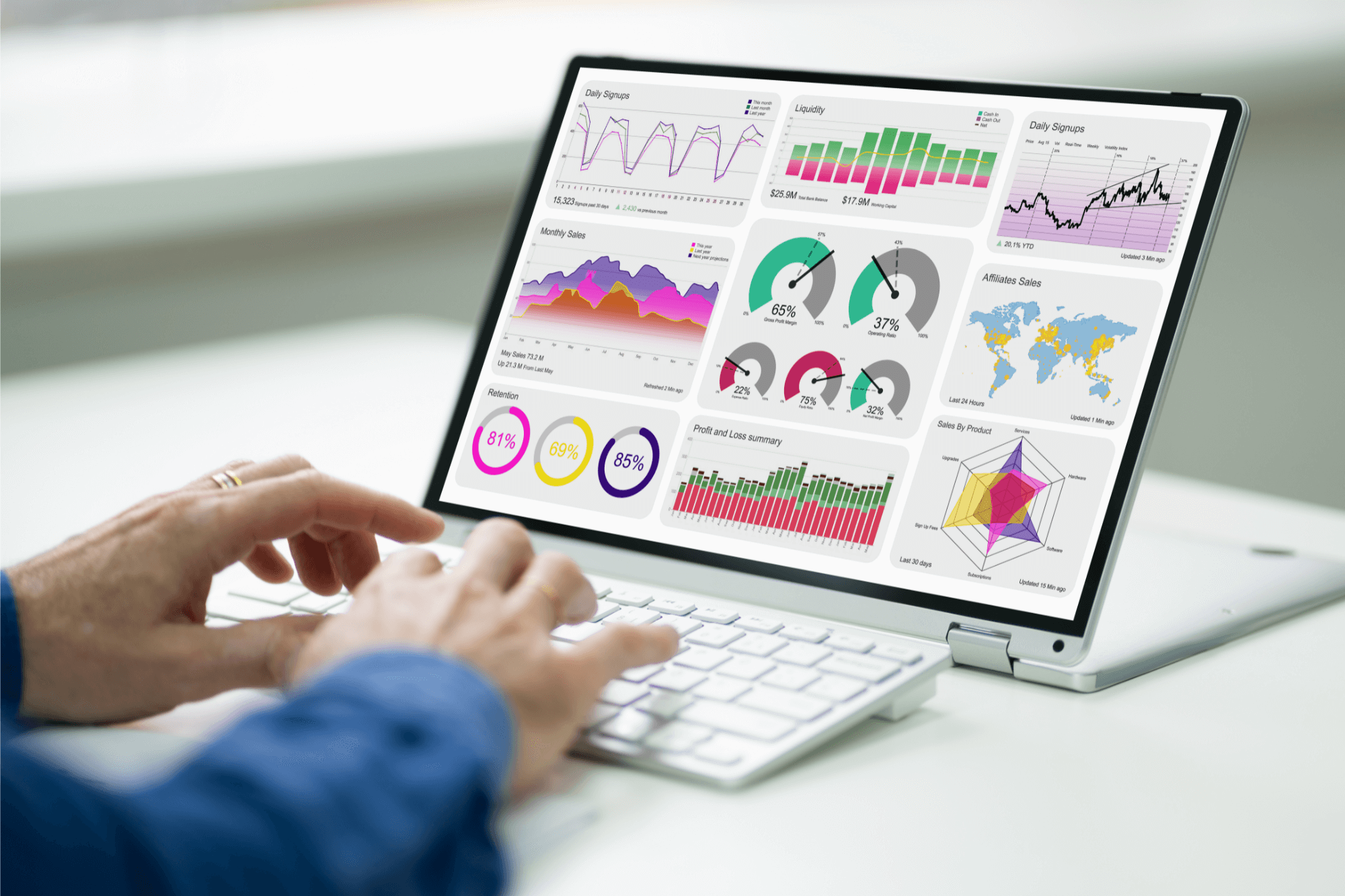
Managing a worldwide supply chain is an intricate task. As a leader, you juggle a vast network of stakeholders to deliver top-notch customer experiences. Amidst so many supply chain moving parts and massive data flows, constant disruptions add to the challenge. This complexity, by nature, generates a wealth of data.
Yet, what if there was a guiding light within this maze of complexity? Transforming waves of raw data into navigable dashboards, supply chain analytics are your compass, guiding decisions toward improved outcomes. In this increasingly competitive market, harnessing the power of these analytics is no longer a luxury but a necessity. A recent Gartner study underlines this, indicating that 79% of supply chain leaders plan to equip their teams with advanced analytics training. But why is this crucial to the success of your supply chain?
In this article, we delve into the potential of a logistics dashboard – your roadmap to growth. We will demonstrate the benefits of data analytics software and its applications and guide you on your journey to develop these vital tools. Are you ready to extract the goldmine of insights hidden in your supply chain data?
Understanding Analytic Dashboards
The logistics analytics dashboard, acting as your command center, gathers a plethora of data points into one accessible interface, showing your path toward efficient logistics management.
Picture a logistics dashboard as your digital Swiss Army Knife. It brings real-time inventory levels, warehouse operations, and logistics management data into sharp focus. But unlike traditional knives, this tool is more than just a sharp blade – it’s a toolkit full of insights. Think of logistics dashboard examples that instantly reveal transportation bottlenecks or inventory shortages, allowing you to proactively course-correct before minor issues snowball into major problems.
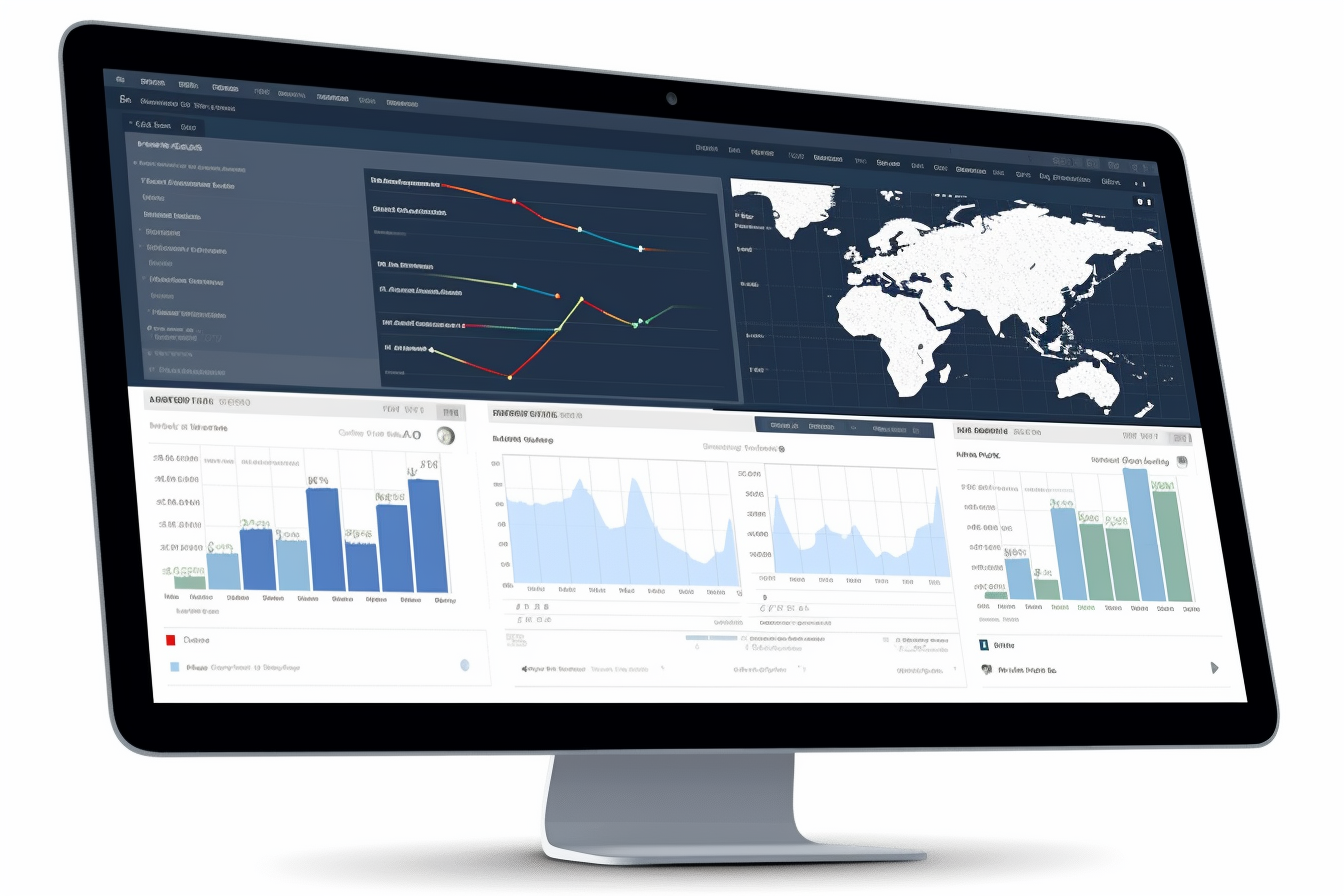
It’s not just about displaying data; it’s about presenting it in a digestible, visual form. This is where a supply chain dashboard truly shines, transforming columns of numbers into understandable charts and graphs. You instantly see where you stand, what’s working, and what needs improvement.
The power of real-time data cannot be overstated in the logistics realm. Imagine a supply chain management software with a dashboard that provides immediate insights into your warehouse’s performance or the status of shipments in transit. This real-time data lets you adapt your logistics strategies on the fly, saving precious time and resources.
The Role of Analytics in Logistics
Imagine the sheer volume of data generated every day – from shipments and their specifications to contact details and returns. It’s like standing in a storm of information, where missing out on crucial data points might mean losing a competitive edge. This is where the logistics analytics dashboard can help you make sense of colossal data sets.
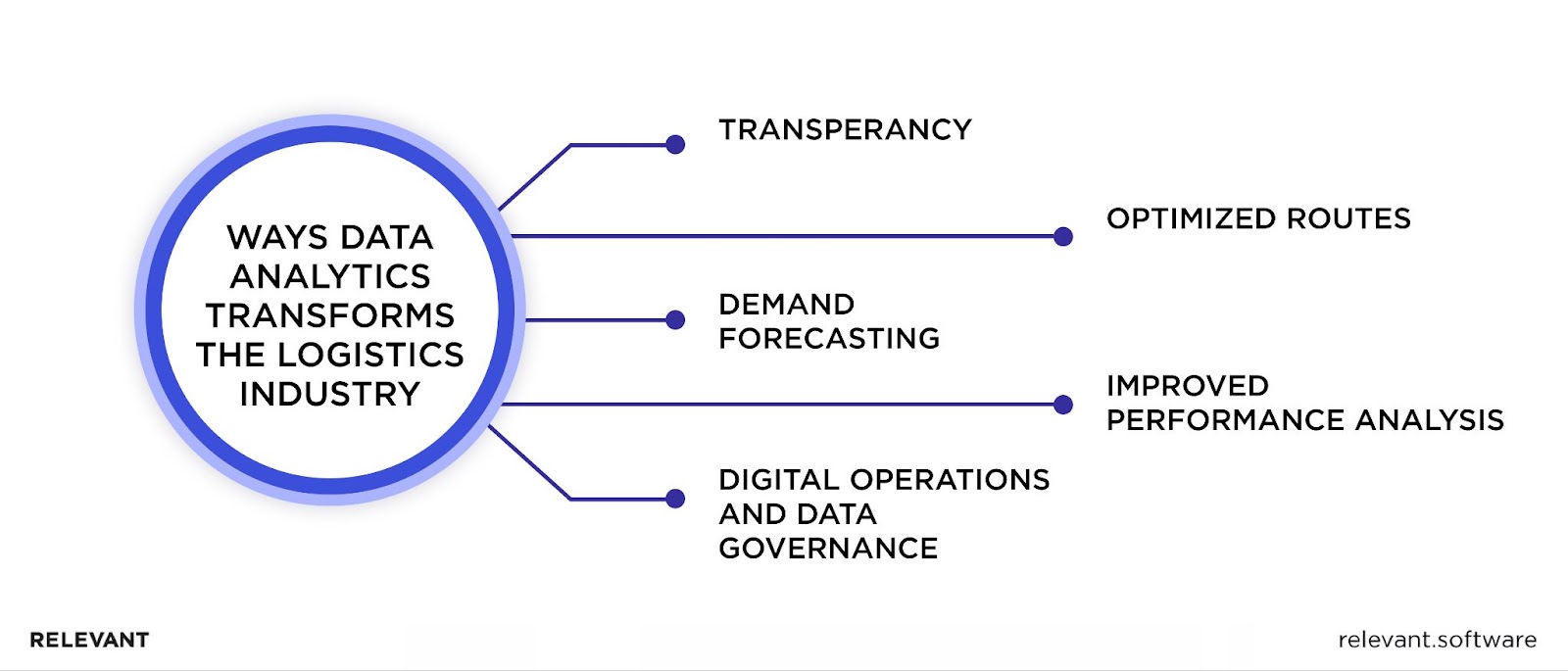
So, what are analytics’ most significant roles in the logistics industry?
- Visibility. With a supply chain dashboard, you can track your shipments from point A to point B as effortlessly as a bird soaring overhead. This bird’s eye view of your operations helps you deliver superior logistics services while ensuring efficient supply chain management.
- Route optimization. It’s akin to an advanced GPS system that suggests the optimal route for deliveries, considering variables such as traffic conditions, weather, and fleet data. This guidance allows your deliveries to reach their destination safely and timely, boosting your logistics operation’s efficiency.
- Performance analysis and improvement. Using a logistics analyst KPI dashboard as part of your analytics tools is like having a diligent health monitor for your logistics. It scans key performance indicators, flags potential issues such as delays, lost items, or price fluctuations, and provides valuable insights. This clear operational view fosters continuous improvement, ensuring your logistics processes remain efficient and optimized.
- Demand forecasting. Think of analytics as your logistics oracle, offering glimpses into future market trends and helping you stay prepared for any shifts in demand. It empowers you to plan more accurately and respond more swiftly to changes.
- Digital operations and data governance. It orchestrates your logistics symphony, assuring cohesion and integrity in your supply chain, all while optimizing operational costs.
In the grand theatre of logistics, analytics is the main protagonist, leading the way toward efficiency, productivity, and success.
Read also about key ways AI boosts the logistics industry.
Benefits of Analytics Dashboards in the Logistics Industry
Supply chain dashboards play a critical role in the logistics industry, acting as a central nervous system, translating complex data into visual, easy-to-understand, and actionable information. As we explore the benefits of analytics dashboards, we’ll discover how they can be the secret weapon for logistics business leaders looking to achieve superior results, optimize operations, and stay ahead in this highly competitive sector.
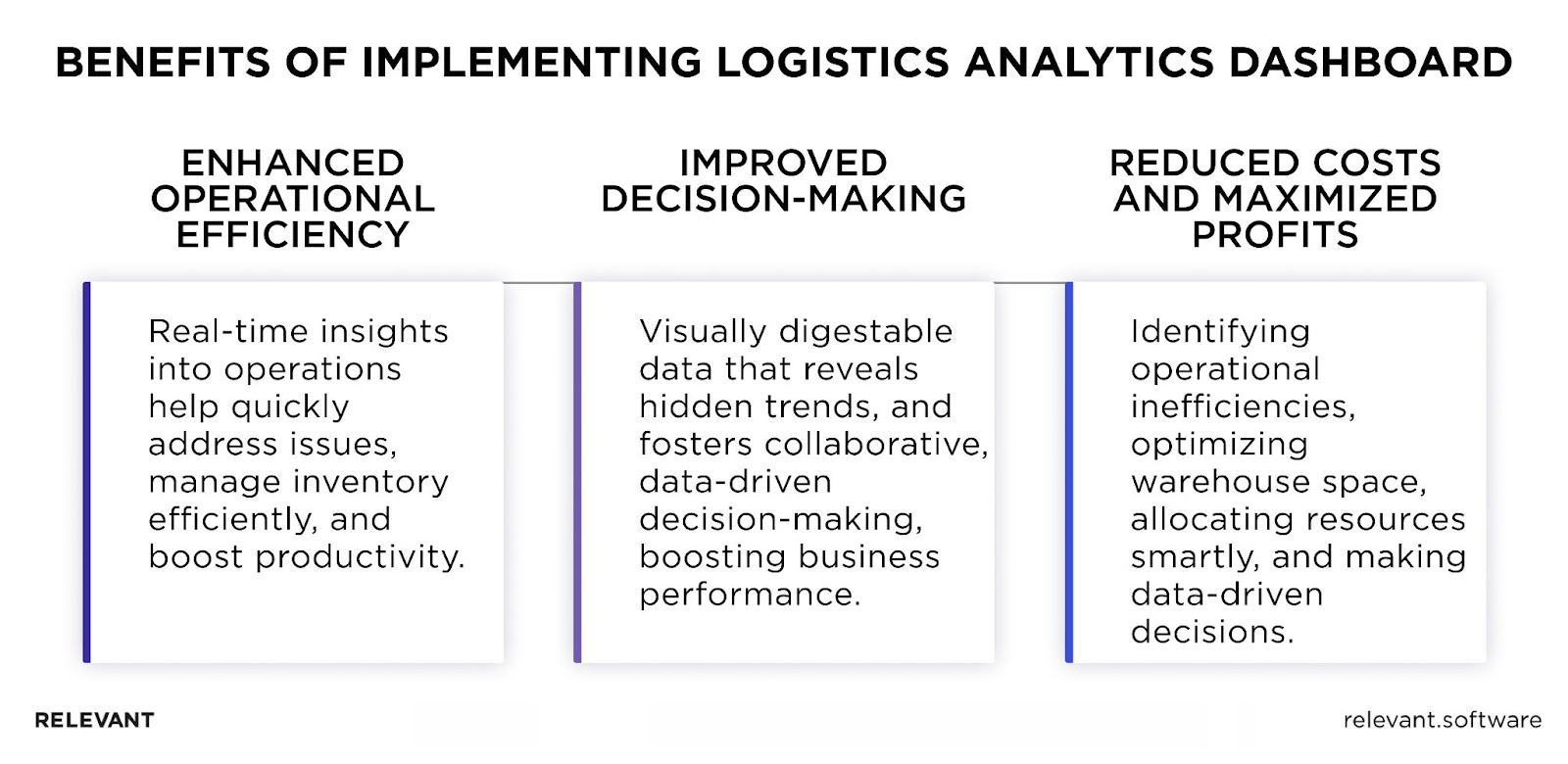
Enhancing Operational Efficiency
Analytics dashboards serve as the control center for your logistics operations. They provide a snapshot view of critical data from different sources, offering a clear picture of your processes.
The beauty of these dashboards lies in their real-time data processing capability. Picture a scenario where your fleet is stuck in traffic or a delay occurs in the warehouse; your logistics dashboard promptly alerts you, allowing immediate action. The result? Minimized disruptions and maximized productivity.
Your inventory management software is another area where dashboards play a pivotal role. Through predictive analytics, they can forecast demand and help manage inventory levels effectively, preventing overstocking or stockouts. This leads to lower holding costs and improved customer satisfaction. In inventory management, precision is key, and a custom dashboard can be a game-changer. Opting for inventory management software development services, you can be sure your dashboard is finely tuned to meet the unique needs of your supply chain and your stock levels are managed with surgical precision.
Improving Decision-Making in Logistics
Analytics dashboards don’t just aggregate and present data; they serve as a compass guiding you through a sea of information to your most critical decisions. A logistics analytics dashboard distills a multitude of data into a visually digestible format, laying the foundation for smart decision-making. A survey by PwC revealed that businesses heavily relying on data are thrice as likely to witness enhancements in their decision-making processes as opposed to their counterparts who scarcely depend on data.

The advanced analytical capabilities of these dashboards can uncover trends and patterns in your data that may not be immediately apparent. For example, they might reveal peak times for product demand, areas in your supply chain with recurrent issues, or potential cost-saving opportunities. By acting on these insights, you can strategically allocate resources, optimize processes, and ultimately enhance your business performance.
Importantly, an analytics dashboard also supports collaborative decision-making. By having a shared view of the data, teams can align their strategies and goals, reducing misunderstandings and conflicts. This collective intelligence leads to more effective decisions and cultivates transparency and confidence within your organization.
Cost Reduction and Profit Maximization
Consider operational costs, one of the major expense categories in logistics. An analytics dashboard can help pinpoint inefficiencies in your supply chain, be it a recurrent bottleneck in a warehouse or a delivery route that’s longer than necessary. By shedding light on these issues, the supply chain dashboard allows you to resolve them, cutting unnecessary costs.
The benefits extend to warehouse management as well. With real-time tracking and predictive analytics, warehouse management software with analytics dashboards can help you optimize space utilization. The system can track the locations and quantities of items stored in a warehouse, providing insights into how well space is used. Based on this data, managers can reorganize the warehouse layout to maximize space utilization, reducing the need for additional storage facilities and cutting costs significantly. As a logistics development company, we build tailored warehouse management solutions, which will equip you with the tools to meticulously analyze and streamline your warehouse processes.
Resource allocation is another critical area where a logistics analytics dashboard can make a significant impact. It can help you understand where your resources are being used effectively and where they’re not. This means you can reallocate resources from low-impact areas to those that generate higher returns, increasing your overall profitability.
On the revenue side, a supply chain dashboard can help you maximize profits by enabling better decision-making. For instance, it can analyze market trends and customer behavior, helping you forecast demand more accurately. This means you can plan your logistics operations to meet peak demand periods, capitalizing on sales opportunities and boosting profits.
BARC research found that those leveraging big data experienced an upswing in profits by 8% and a simultaneous cost downturn by 10%. An instance that mirrors this finding is that of UPS, a well-known logistics company. By implementing big data analytics in their operations, UPS reportedly saved nearly $300-$400 million annually, thus substantiating the transformative potential of big data in bolstering profits.
Application of Analytic Dashboards in the Logistics Industry
Let’s explore some practical ways in which analytics software is applied and witness how they’re shaping the future of logistics.

Tracking and Visualization of Logistics Data
Imagine trying to navigate a busy city without a map or GPS. In the sprawling metropolis of logistics data, you deal with multiple variables, from inventory levels to delivery times and route optimizations. Without a clear, visualized understanding of these elements, making accurate, timely decisions would be next to impossible.
This is where business dashboards and analytics software come in. By tracking crucial data points across the supply chain, these tools create a dynamic visual snapshot of the entire operation. This visual component makes patterns, trends, and anomalies instantly recognizable. Moreover, by enhancing supply chain management with IoT, you’ll get a highly connected ecosystem with improved tracking capabilities and predictive analytics.
Furthermore, supply chain dashboards are not just passive observers. They alert you to potential bottlenecks or shortages, facilitating a proactive approach as opposed to reactive measures. You gain the capability to develop data-driven strategies that bolster your operations, enhancing efficiency and cost-effectiveness.
Consider the power of a logistics dashboard in inventory management. You can identify stock levels, sales rates, and anticipated demand, significantly reducing the risk of overstocking or understocking. This timely insight can lead to smarter purchasing decisions, saving costs and ensuring a seamless supply chain.
As the logistics industry evolves, the integration of analytic dashboards becomes not just a route to success but a journey toward a more data-informed future.
Specific Uses of Analytic Dashboards in Logistics
Analytic dashboard software in logistics is not just about pretty graphs and pie charts; they’re powerful tools used to inform, optimize, and transform operations. They serve as the brain of your logistics business, performing complex calculations and displaying outcomes in a simple, digestible manner. But how do they come into play in the daily hustle of logistics operations? Let’s delve into some specific use cases of analytic software in the logistics sector, highlighting how it influences your strategic decisions and operational effectiveness.
Inventory Management
Keeping a precise track of stock levels, knowing when to reorder, and understanding which items are fast-moving versus those collecting dust on your shelves – are all vital for a smoothly running operation. And analytic software can inject efficiency into your inventory management process.
A logistics dashboard constantly monitors stock levels across multiple warehouses, updating in real-time, ensuring you always have an accurate picture of your inventory situation. No more stockouts or overstocking – it’s all about achieving that optimal inventory level, reducing storage costs, and ensuring customer satisfaction.
Furthermore, dashboards can offer insights into sales trends, allowing you to forecast demand more accurately. Is there a certain product that becomes a hot cake during holiday times? Your dashboard can highlight this, allowing you to plan your stock accordingly.
Lastly, through integration with other business systems like procurement and sales, a logistics analytics dashboard provides a holistic view of your inventory flow. You can track a product’s journey right from ordering from a supplier to selling to the customer. This helps identify bottlenecks and inefficiencies, contributing to informed decision-making.
Route Optimization
Supply chain dashboards are the smart, data-driven answer to effective route optimization. This software pulls together vital data points like time sensitivity, traffic patterns, and more, enabling more streamlined last-mile delivery. The assumptions and probability for human error in manual route planning? Say goodbye to them.
Imagine having an analytical tool that not only schedules deliveries based on solid data but also offers a mobile interface. This connectivity links the main logistics dashboard at your business premises with your drivers on the go, creating a seamless, real-time flow of information. The benefits are clear – reduced costs for urgent deliveries and lower driving expenses over time, thanks to consistent on-time performance.
But the impact doesn’t stop at cost savings. Optimized route planning, facilitated by analytic software, also contributes to customer satisfaction. Deliveries arrive when expected, and customers remain content. It’s a win-win situation – your logistics business saves money, and your customers are pleased with the service.
Delivery Tracking
Picture this: an intelligent system that not only monitors routes and delivery points but also tracks the entire shipment process. It’s as if you’re riding along with every parcel, gaining live insights. Logistics analytic software makes this level of visibility possible, and it’s a game-changer in improving customer service.
But the brilliance of data analytics dashboards doesn’t stop there. They can also predict potential delays by digesting and analyzing raw data. Imagine being able to foresee issues before they even happen. Thanks to data analytics, you’re not just fixing problems; you’re preventing them.

For example, if your dashboard detects recurring traffic bottlenecks on certain routes at specific times, it can suggest alternate paths or dispatch times to avoid delays. Such preemptive measures can save you time, cut expenses, and please your clientele.
Demand Forecasting
Today the ability to accurately predict demand is akin to having a superpower. It’s about being prepared, making informed decisions, and staying ahead of the curve. And that’s precisely what a logistics analytics dashboard offers.
Data analytics software continually enhances productivity and refines your supply chain demand. It provides real-time insights and offers exceptional connectivity across your network, acting as the backbone of your supply chain management.
But their magic extends beyond connectivity. Analytic dashboards improve the demand-supply balance, allowing you to manage resources more efficiently. When you know what’s coming, you can better utilize your assets, enhancing operational clarity and efficiency.
One might say that the future of logistics revolves around metrics, KPIs, and forecasting. Real-time data provided by supply chain dashboards help you monitor performance continuously, enabling you to spot bottlenecks and potential issues promptly. It’s like having a sixth sense for spotting picking rate problems, picking procedure delays, or missing shipment products.
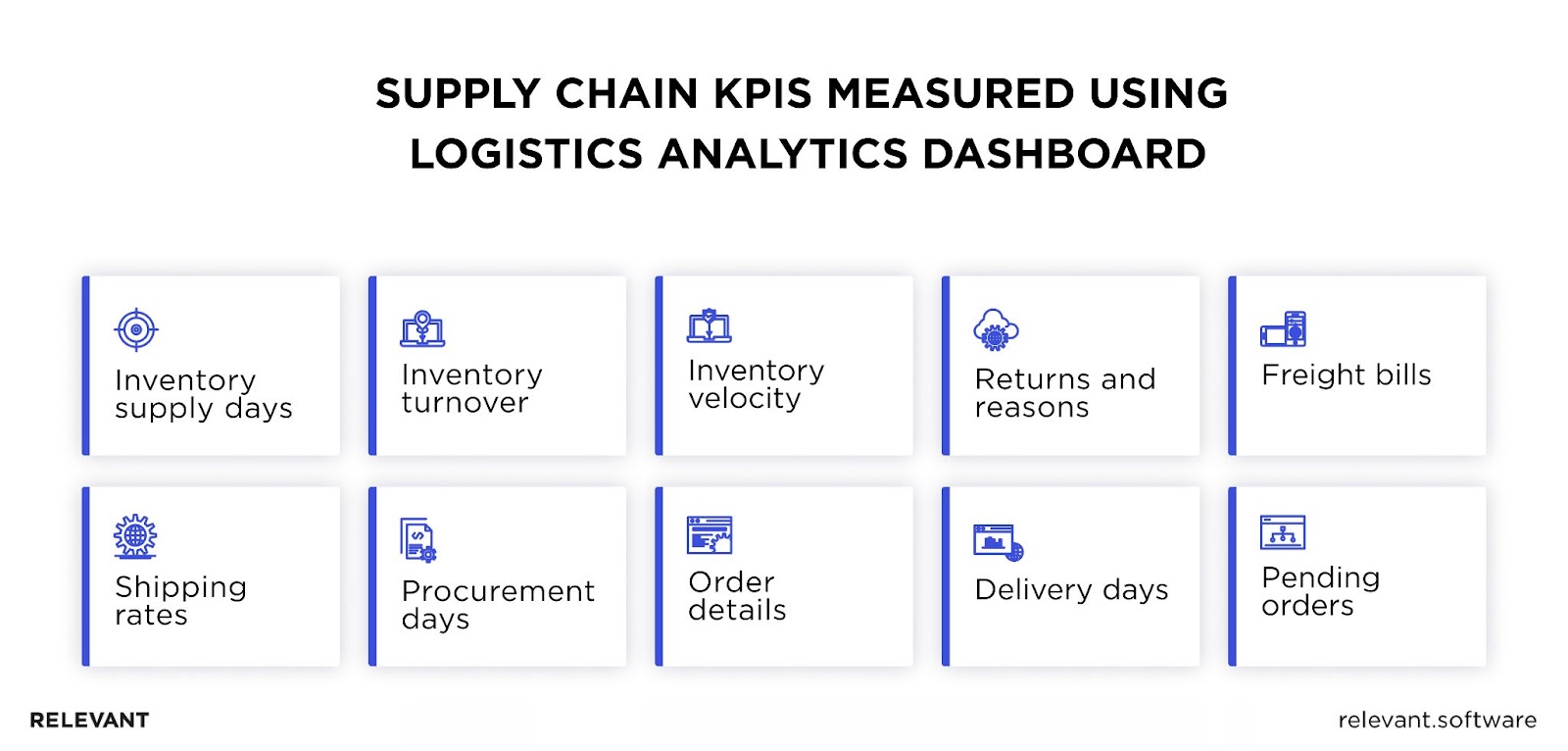
Furthermore, predictive analytics, a feature offered by advanced logistics analytic software, can forecast demand surges for any product, anywhere, anytime. This foresight allows you to anticipate drastic shifts in demand, prevent inventory shortages, and even yield significant cost savings.
Final Thoughts
The transformative power of supply chain dashboards in logistics cannot be overstated. By enabling precise tracking, enhancing inventory management, optimizing routes, improving delivery tracking, and forecasting demand accurately, they streamline operations and position your logistics businesses for exponential growth and efficiency.
More importantly, data analytics allows logistics companies to transition from reactive to forward-thinking, proactive decision-making. It gives them the ability to spot trends, identify bottlenecks, and leverage opportunities, thereby reducing operational costs and boosting profits.
However, the secret sauce to unlocking the full potential of your data lies in their effective implementation and customization of logistics dashboards based on your business’s unique needs and challenges. And that’s where Relevant Software shines.
At Relevant, we pride ourselves on delivering logistics software solutions tailored to your needs. Our team is not only adept at creating intuitive, easy-to-use logistics software, but we’re also passionate about helping you make sense of your data. We believe in empowering you to fully leverage the power of analytics, and we’re committed to making the data visualization process as smooth as possible, regardless of the complexity of the task at hand.



